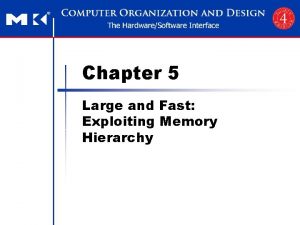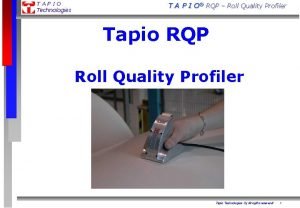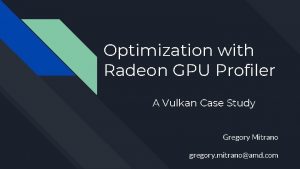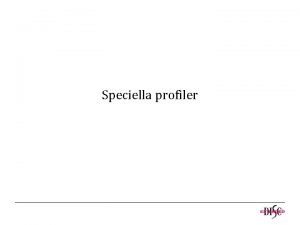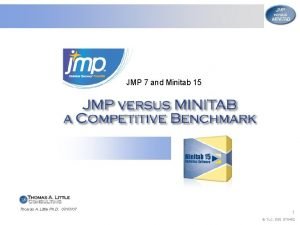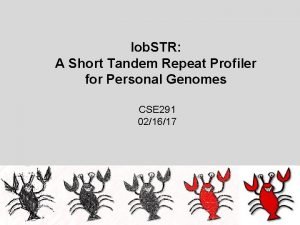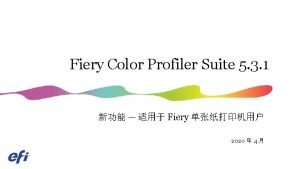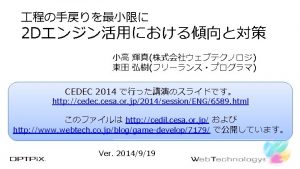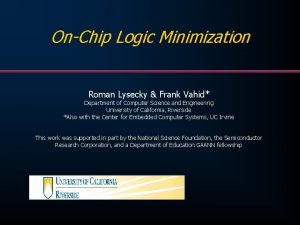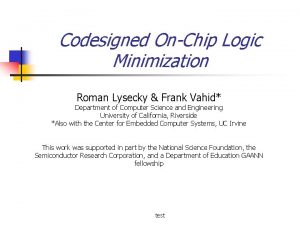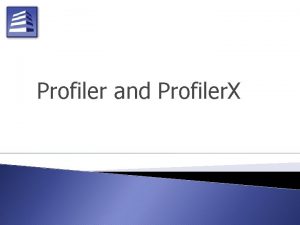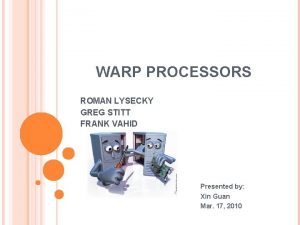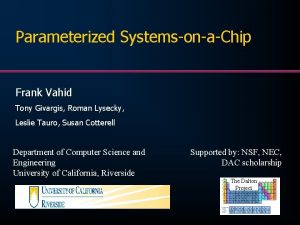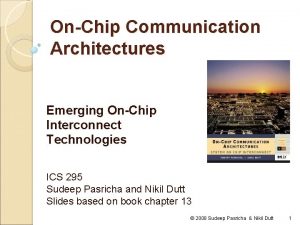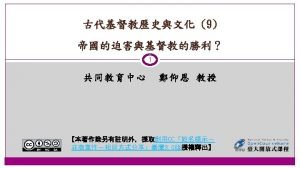A Fast OnChip Profiler Memory Roman Lysecky Susan





































- Slides: 37

A Fast On-Chip Profiler Memory Roman Lysecky, Susan Cotterell, Frank Vahid* Department of Computer Science and Engineering University of California, Riverside *Also with the Center for Embedded Computer Systems, UC Irvine This work was supported in part by the National Science Foundation

Outline • Introduction • Problem Definition • Profiling Techniques • Pipelined Binary Search Tree • Pro. Mem • Conclusions 2

Introduction Our Solution: Add On-Chip Profiler Memory to Monitored Bus • Accepts 1 pattern/cycle • Keeps Exact Counts Monitor Embedded Bus I$ Mem Processor D$ Bridge Goal: Determine # of Times Each Target Pattern Appears on the Bus Per. Pro. Mem Per. 3

Introduction … Lo prog. c … Lo op A } N Profile // small Loop B for(x=0; …; …) op … Most Instructions Executed Instructions void compute() { // small Loop A for(i=0; …; …) Profile Information Move Loop A to HW Mem Processor Configure FPGA Per. Synthesis FPGA 4

Introduction • Profiling Can Be Used to Solve Many Problems – Optimization of frequently executed subroutines – Mapping frequently executed code and data to non-interfering cache regions – Synthesis of optimized hardware for common cases – Identifying frequent loops to map to a small lowpower loop cache – Many Others! 5

Problem Definition • Objective – Count number of times each target pattern appears on bus B Input Patterns P={pi , …, pm} Processor Bus B p 1 p 2 … pm Mem • Requirements – Accept input patterns on every clock cycle – Monitoring any bus, e. g. , deeply embedded buses in SOCs – Non-intrusive – Exact target pattern count Per. Target Patterns TP = {tpi, …, tpm} Target Pattern Counts CTP = {ctpi, …, ctpm} Per. TP CTP tp 1 11203 tp 2 8876 … … tpm ctpm 6

Profiling Techniques - Software • Instrumenting Software – Adding code to count frequencies of desired code regions • Problems – Incurs runtime overhead – Possibly changes program behavior – Increase in code size Processor p 1 p 2 … pm prog. c Per. Mem Per. for( … ){ … ctpm++; } 7

Profiling Techniques - Software • Periodic Sampling – Interrupt processor at periodic interval – Read program counter and other internal registers Processor p 1 p 2 … pm prog. c Per. Mem Per. • Problems – Disruption of runtime behavior during interrupt – Inaccurate // ISR period = 10 ms ISR{ //update profile info } 8

Profiling Techniques - Software • Simulation – Execute application on instruction set simulator – Simulator keeps track of profile information • Problems – Difficult to model external environment which leads to inaccuracy – Extremely slow prog. c ISS profile information 9

Profiling Techniques - Hardware • Logic Analyzer – Probes placed directly on bus to be monitored • Problems Processor Mem p 1 p 2 … pm Per. – Cannot monitor embedded buses 10

Profiling Techniques - Hardware • Processor Support – Mainly event counters – Monitored events include cache misses, pipeline stalls, etc. • Problems Processor Mem p 1 p 2 … pm Per. – Few registers available – Reconfiguration needed to obtain a complete profile – Leads to inaccuracy 11

Profiling Techniques - Hardware • Content-addressable memories (CAMs) – Fast search for a key in a large data set – Returns the address at which the key resides in a memory Processor Per. p 1 p 2 … pm Mem CAM • Types – Fully Associative – RAM coupled with a smart controller 12

Profiling Techniques - Hardware • Fully Associative CAMs – Simultaneously compares every location with the key Processor • Problems CAM Per. Mem tp 1 = tp 2 = tp 3 = … – Does not scale well to larger memories – Increased access time as CAM size grows – Large Power Consumption p 1 p 2 … pm tpm = 13

Profiling Techniques - Hardware • RAM coupled with a smart controller Processor p 1 p 2 … pm – Efficient lookup data structure in memory such as a binary tree or Patricia Trie CAM Per. SRAM Ctrl • Problems Mem – Multiple cycle lookup 14

Observations • Not necessary to have 1 cycle look up • Only need to accept one input pattern every cycle 15

Queueing Bus B • Hold input patterns in queue until we are able to process them FIFO • Problems – Does not work with patterns arriving every clock cycle CAM Ctrl SRAM 16

Pipelining • Implemented in processors such that instructions can be executed every cycle • Can we use pipelining to solve our problem? 17

Pipelined CAM • Large CAMs required long access times • Partition large CAM into several smaller CAMs CAM Pipeline Reg – Requires pipelining to reduce access time – Provides solution to access time problem – Requires Large Area – Large Power Consumption CAM 18

Pipelined CAM • Entries can be stored in a CAM in any order – requires sequential lookup in pipelined CAM approach • Is there a benefit to sorting the entries? – not necessary to search all entries – leads to faster lookup time • Tree structure provides a inherently sorted structure – Search time remains a problem – Can we pipeline the structure? 19

Pipelined Tree • Solves access time problem – One memory access per level • Solves area problem – Single comparator per level – Each level grows by factor of two – For large memories, comparators are negligible = = 20

Pipelined Binary Search Tree Root Node Each node has at most two children h Right child < Parent Left child > Parent k j d i f b g e c a 21

Pipelined Binary Search Tree Stage 0 Searching for Input Pattern: f Stage 1 Stage 2 Stage 3 f < h, go right h k j d i f b g e f > d, go left f = f, Found! c a 22

Pipelined Binary Search Tree Searching for Input Pattern: e Stage 0 e < h, append 0 Stage 1 Stage 2 Stage 3 to address h 11 k 1 0 j d 10 01 i f e > d, append 1 to address 00 e < f, append 0 to address b 011 010 001 000 g e c e = e, Found! a 23

Pipelined Binary Search Tree Searching for Input Pattern: e, f Stage 0 fe << h, h, append 00 0 Stage 1 Stage 2 Stage 3 to address h j k i ef >> d, d, append 11 d to address 01 fe =< f, f, Found! append 0 ff to address b 010 g ee e = e, Found! c a 24

Stage 0 Pipelined Binary Search Tree Stage 1 h Stage 3 Stage 2 11 k 1 0 j d 10 01 i f Standard Memories 00 b 011 010 001 000 - - g e c a 25

Pro. Mem – Module Design Input Pattern ps_i As_i > ps Input Pattern Enable Search Address > As Search Address (Next Stage) ps_o As+1_o cen_i > cen Pipeline regs Enable (Next Stage) Pro. Mem stage s cen_o 26

Pro. Mem – Module Design ps_i As_i > ps Target Pattern Memory cen_i > As > cen Pipeline regs TPMs (2 s×w) rd addr dout Pro. Mem stage s ps_o As+1_o cen_o 27

Pro. Mem – Module Design ps_i As_i > ps cen_i > As > cen Pipeline regs TPMs (2 s×w) rd addr dout Target Pattern Found Search for Target Pattern Compare > = Target Pattern Not Found – Enable Next Stage Pro. Mem stage s ps_o As+1_o cen_o 28

Pro. Mem – Module Design ps_i As_i > ps cen_i > As > cen TPMs (2 s×w) rd addr Pipeline regs CMs (2 s×c) rd addr wr dout Target Pattern Count Memory Compare > = Pro. Mem stage s ps_o As+1_o cen_o 29

Pro. Mem – Module Design ps_i As_i > ps cen_i > As > cen TPMs (2 s×w) rd addr Pipeline regs 1 dout Compare > = CMs (2 s×c) rd addr wr dout +1 When Target Pattern Found - Update Count Value Pro. Mem stage s ps_o As+1_o cen_o 30

Pro. Mem – Module Design ps_i As_i > ps cen_i > As > cen TPMs (2 s×w) rd addr Pipeline regs 1 dout CMs (2 s×c) Pipeline Register Memories rd addr wr dout Module Controller Compare > = +1 Module. Controller Pro. Mem stage s ps_o As+1_o cen_o 31

Pro. Mem - Interface • Simple Interface – Internal interface Processor • Enable signal • Connection to monitored bus Mem clk – External interface • Read enable • Write enable • Connection to Pro. Mem pattern input bus p 1 p 2 … pm Per. cen addr ren wen Pro. Mem Per. 32

Pro. Mem - Layout • Efficient Layout – Achieved by simply abutting each module with the next – Results in very short bus wires between each module ps_i As_i > ps cen_i > As > cen TPMs (2 s×w) rd addr Pipeline regs 1 dout Compare > = CMs (2 s×c) rd addr wr dout +1 Pro. Mem stage s ps_o As+1_o cen_o 33

Pro. Mem Results – Area* Module overhead only 1% *Area obtained using UMC. 18 technology library provided by Artisan Components 34

Pro. Mem Results – vs. CAM design is 46% larger than Pro. Mem 35

Pro. Mem Results – Timing vs. CAM access time grows with CAM size Pro. Mem access time remains constant (Due to Pipelining) 36

Conclusions • Introduced a new memory structure specifically for fast on-chip profiling • One pattern per cycle throughput • Simple interface to monitored bus • Efficient design is very scalable 37
 Differentiate between acid fast and non acid fast bacteria
Differentiate between acid fast and non acid fast bacteria Example of acid-fast bacteria
Example of acid-fast bacteria Large and fast: exploiting memory hierarchy
Large and fast: exploiting memory hierarchy Onet profiler
Onet profiler Tapio technologies
Tapio technologies Cisco nac profiler
Cisco nac profiler Walking floor profiler
Walking floor profiler Radeon developer panel
Radeon developer panel Onet assessment
Onet assessment Naviance career interest profiler
Naviance career interest profiler Specialla profiler+
Specialla profiler+ Lixi profiler
Lixi profiler Minitab 15
Minitab 15 Lixi profiler
Lixi profiler Lixi profiler
Lixi profiler O*net work importance profiler
O*net work importance profiler Pbt profiler
Pbt profiler Lixi profiler
Lixi profiler Lixi profiler
Lixi profiler Lidar wind profiler
Lidar wind profiler Onet work importance profiler
Onet work importance profiler Profilor 360
Profilor 360 Lixi profiler
Lixi profiler Fiery color profiler suite download
Fiery color profiler suite download Trepn profiler
Trepn profiler Prototypes in semantics
Prototypes in semantics Primary memory and secondary memory
Primary memory and secondary memory Virtual memory and cache memory
Virtual memory and cache memory Implicit memory
Implicit memory Virtual memory in memory hierarchy consists of
Virtual memory in memory hierarchy consists of Long term memory vs short term memory
Long term memory vs short term memory Logical address
Logical address Eidetic memory vs iconic memory
Eidetic memory vs iconic memory Internal memory and external memory
Internal memory and external memory Which memory is the actual working memory?
Which memory is the actual working memory? Shared vs distributed memory
Shared vs distributed memory Politheistic
Politheistic Roman republic vs roman empire
Roman republic vs roman empire


